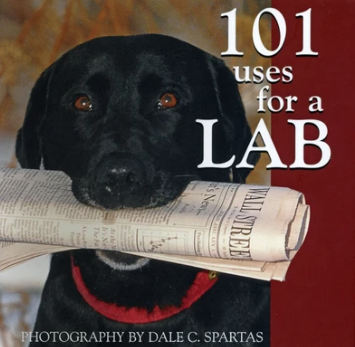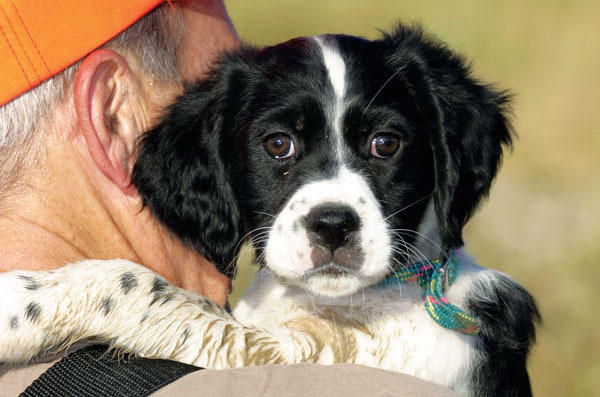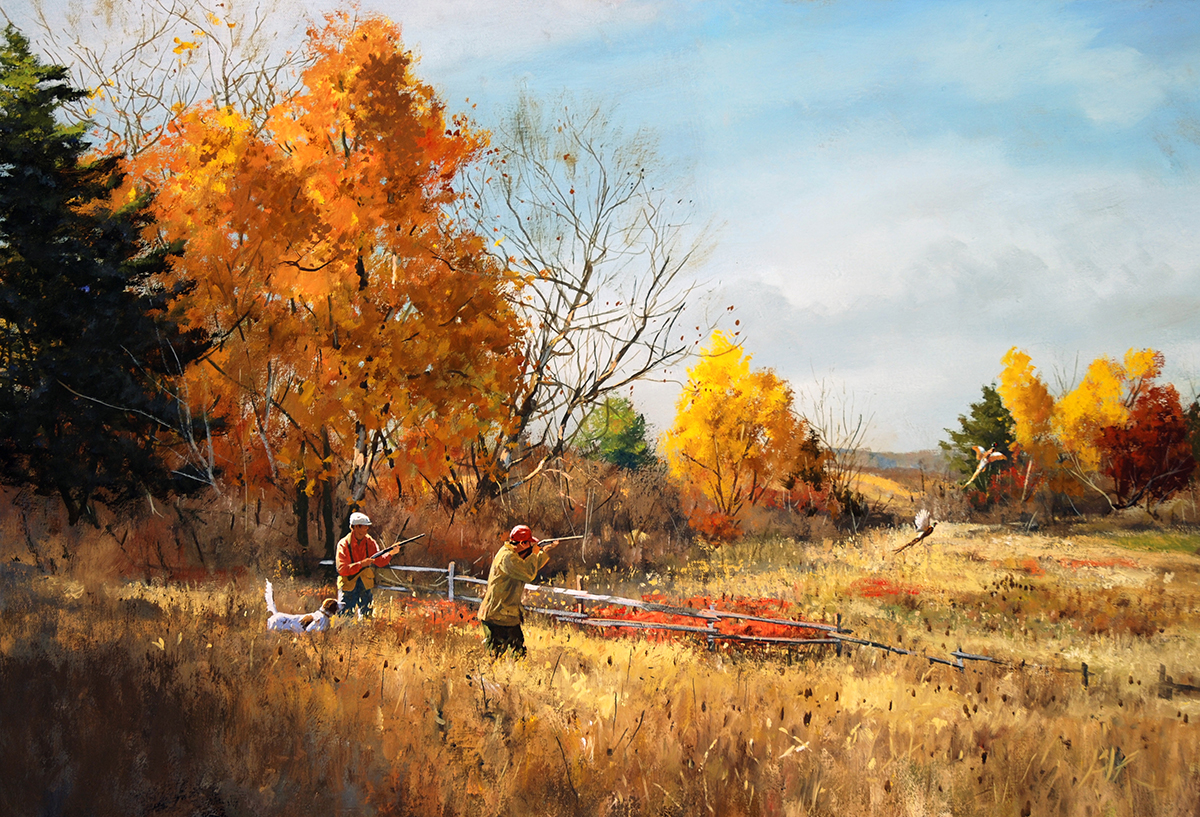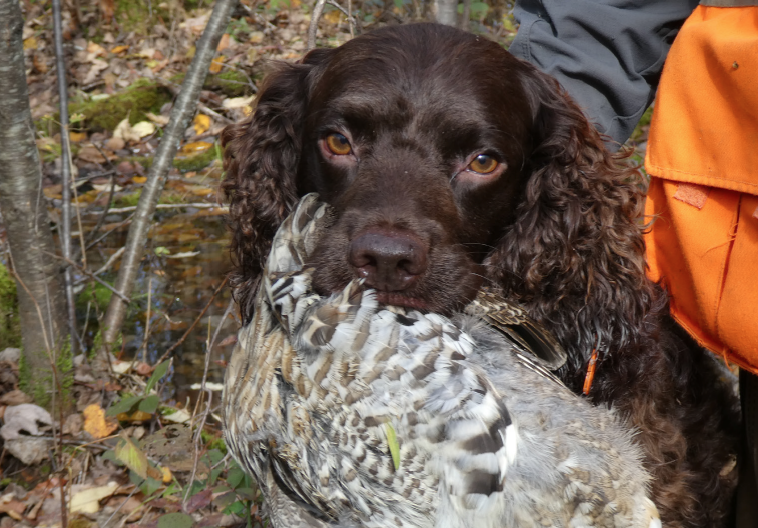From the Nov./Dec. issue of Sporting Classics, on newsstands Oct. 29.
You could have knocked me over with a woodcock feather. I had attended a number of Purina-sponsored events over the years, all of them fairly intimate affairs—maybe 20 people, about two-thirds of them writers and editors, the rest various authorities on training and canine nutrition brought in to share their expertise and provide us media types with grist for our mills. So when I arrived at the hotel outside St. Louis for a gathering Purina had billed as the “Sporting Dog Summit,” I expected something along the same lines.
I followed the signs down a long hallway, stepped through the open doors of the banquet room . . . and while I can’t say for certain that my jaw dropped, I’m glad I didn’t have to speak for a while. There were 80 or 90 people in the room if there was one, and as I looked around and began to identify the other participants, my mild state of shock morphed into acute disbelief.
Was that big, craggily handsome man (think Waylon Jennings with a decent haircut) actually Robin Gates, the trainer and handler of the two-time reigning National Champion, Shadow Oak Bo? No way! How the hell did they con him into leaving his summer camp in Manitoba, where he’d been prepping his star-studded string of pointers and setters for the upcoming prairie trials?
The trim, youthful-looking guy over there—my God! It had to be Mike Lardy, the winner of a record seven National Open Retriever Championships and the youngest person ever elected to the Retriever Field Trial Hall of Fame. And unless I missed my guess, Lardy was talking to Danny Farmer, another Retriever Hall-of-Famer who’s won more Open stakes than any handler—ever.
The woman sitting at the table in the back of the room, the one with the dark, wavy hair and the aura of intense concentration . . . Could that be Sherry Ebert, the better half of the team that guided the Smith Setters to unprecedented achievements and, for good measure, invented the whoa barrel and the roading bar? I’d been wanting to meet her for 30 years! Her first great dog, Tomoka, sired my first real bird dog, a gorgeous roamer named Zack.
No doubt existed, of course, about the identity of the man under the white cowboy hat, the man with the knowing twinkle in his eyes and a smile as wide as the Cherokee Strip: Delmar Smith, the 88-year-young living legend who’s the Elvis of the bird dog world. I noticed a couple other white hats in the room, too, and even without looking I’d have known they belonged to Delmar’s son, Rick, and nephew, Ronnie—a couple pretty fair dog hands in their own right.
Among a knot of guys clustered at the bar (dog guys at a bar—gee, there’s something you don’t see every day), I spied the bearish figure and ruddy countenance of my friend Nolan Huffman, who guided me to my first sage grouse in Montana and whose Brittany, Rusty, is one of the finest bird-finders I’ve ever gunned over. Everywhere I looked, I spotted other familiar faces: Tom Dokken, the inventor of the DeadFowl retrieving dummy; Chris Mathan, the human dynamo behind the Strideaway.com website; Steve Snell of Gun Dog Supply; Ted Gartner of Garmin; Jake Smith, my editor at Pointing Dog Journal and Just Labs; and my Sporting Classics colleague, Ron Spomer.
And those were just the people I knew. Or at least recognized. No wonder they’d dubbed it the Sporting Dog Summit. The logistics of getting all these folks in the same place at the same time had to have been mind-boggling, to say nothing of what it must have taken simply to persuade them to come. Only one man could have pulled it off, a man working the room at that moment, shaking hands and greeting everyone with his trademark sincerity and enthusiasm: Bob West, Purina’s long-time ambassador to the sporting dog world.
Getting all these people together, of course, was precisely the point. Despite everything they have in common, many of them rarely if ever cross paths. It’s just the nature of the business. And while it’s easy to understand why, say, the retriever guys, the pointing dog guys, and the hound guys don’t mix and mingle much, the fact of the matter is that the sporting dog scene is even more compartmentalized than you probably suspect.
For example, Nolan Huffman’s been on top of the shoot-to-retrieve field-trial world for close to 15 years now, while Robin Gates has been the king of the all-age circuit for the last quarter-century. How many times had they met? Exactly none.
Until the Sporting Dog Summit, that is, and their example was just one of many. So this served as a terrific opportunity to make new acquaintances and renew old ones; to connect with peers, share information, and swap war stories. From this perspective alone, the Sporting Dog summit proved tremendously valuable.
There’s really no good snack you can give your dog for a quick, mid-hunt energy boost.
In a sense, though, that was just the backdrop. The more focused portion of the agenda, and the official theme for the summit, was a two-day program entitled “Achieving a Performance Edge.” Held at the Purina Event Center, a state-of-the-art, multi-purpose facility situated on a lovely piece of rolling Missouri countryside, the program had two main thrusts: first, nutrition and conditioning (which go hand in glove, of course) and second, canine sports medicine with a special emphasis on diagnosis and treatment of the most common orthopedic and soft-tissue injuries seen in hunting dogs.The amount of information presented over those two days was staggering. Some of the attendees were taking notes so fast and furious that I swear they broke out in a sweat. So I’m just going to try to boil things down and provide, in bullet-point form, what I think are the most important takeaways.
On the nutrition-and-conditioning side, the presenters were Purina nutritionists Dr. Arleigh Reynolds (who also happens to be a world champion sled dog sprint racer) and Dr. Brian Zanghi.
• Feed a performance diet—28 percent protein and 18 percent fat are the minimums—throughout the year. Switching to a “maintenance” diet in the off-season essentially de-trains your dog’s exercise metabolism to efficiently utilize fat, which is its primary source of fuel.
• The best time to feed is as soon as possible after your dog has cooled down from hunting or other strenuous exercise, and as long as possible—up to 24 hours—before the next serious exercise. And unless there’s an overriding reason to feed more frequently—for example, if you feel that your dog is at risk for bloat—one meal a day is optimal.
• Feeding in the morning prior to a hunt does more harm than good—a lot more. There’s a litany of reasons for this but the bottom line is that dogs, unlike humans, do better without breakfast.
• There’s really no good snack you can give your dog for a quick, mid-hunt energy boost. Most of the products touted for this purpose will, in fact, have just the opposite effect, triggering an insulin spike that causes your dog’s fat-burning “engine” to shut down.
• Instead of adopting a traditional conditioning program that builds in a uniform linear progression, try to mix it up so that the line resembles a series of peaks and valleys, with each successive peak a little higher and each valley a little lower. It’s important to schedule rest periods into the program, too, say every three weeks or so. Canine athletes, just like human ones, are susceptible to burn-out.
• Don’t wait until your dog’s thirsty to give him water. Smaller amounts given more frequently (every 15 minutes or so) are preferable to larger amounts given less often.
With regards to canine sports-medicine, the presenters were Dr. James Cook, an orthopedic surgeon at the University of Missouri, and Dr. Jennell Appel, a specialist in non-invasive treatment and rehabilitation of canine sports injuries.
• The single biggest thing you can do to prevent orthopedic injury is maintain your dog at a healthy weight (and that goes double for puppies). The Purina Body Condition System (easily accessed online) provides a quick and reliable way to evaluate your dog in this regard.
• If you decide to spay/neuter, wait until your dog has attained full skeletal maturity. Early spay/neuter has been linked to a variety of orthopedic problems, among them increased incidence of both hip dysplasia and cruciate ligament injury.
• Don’t turn your dog loose “straight from the crate,” and don’t put him back straight from the field. Ten to 15 minutes of warm-up prior to hunting is critically important, as is a similar period of cool-down after the hunt.
• There is no such thing as “minor” lameness. Any lameness that doesn’t resolve after a few days of rest, and especially any lameness that recurs, is cause for concern and should be addressed immediately—before it devolves into a chronic condition.
• Glucosamine and chondroitin sulfate work well to alleviate symptoms of moderate to severe arthritis, but only when combined. And regardless of any claims to the contrary, their effects are purely palliative. They do not have any preventative or regenerative benefits.
• While stem-cell therapy holds great promise, the experience of both Cook and Appel suggests that platelet-rich plasma is just as beneficial for promoting healing and regeneration of bone and tissue—and it is considerably less expensive. +++
Be sure to pick up the Nov./Dec. issue of Sporting Classics, on newsstands Oct. 29
Cover photo by Ron Spomer.
 A whimsical look at the many roles your beloved Labrador Retriever plays in your life. Just a sample of his many hidden talents include canine garbage disposal, security alarm, world-class athlete, border patrol agent, devoted fishing buddy and low-cost dishwasher.
A whimsical look at the many roles your beloved Labrador Retriever plays in your life. Just a sample of his many hidden talents include canine garbage disposal, security alarm, world-class athlete, border patrol agent, devoted fishing buddy and low-cost dishwasher.
This picture book consists of photos and short captions describing some of the myriad ways in which Labrador Retrievers and their humans interact. The adorable and hilarious photography in this book perfectly captures all the heartwarming, endearing characteristics that make him your best friend. Buy Now




